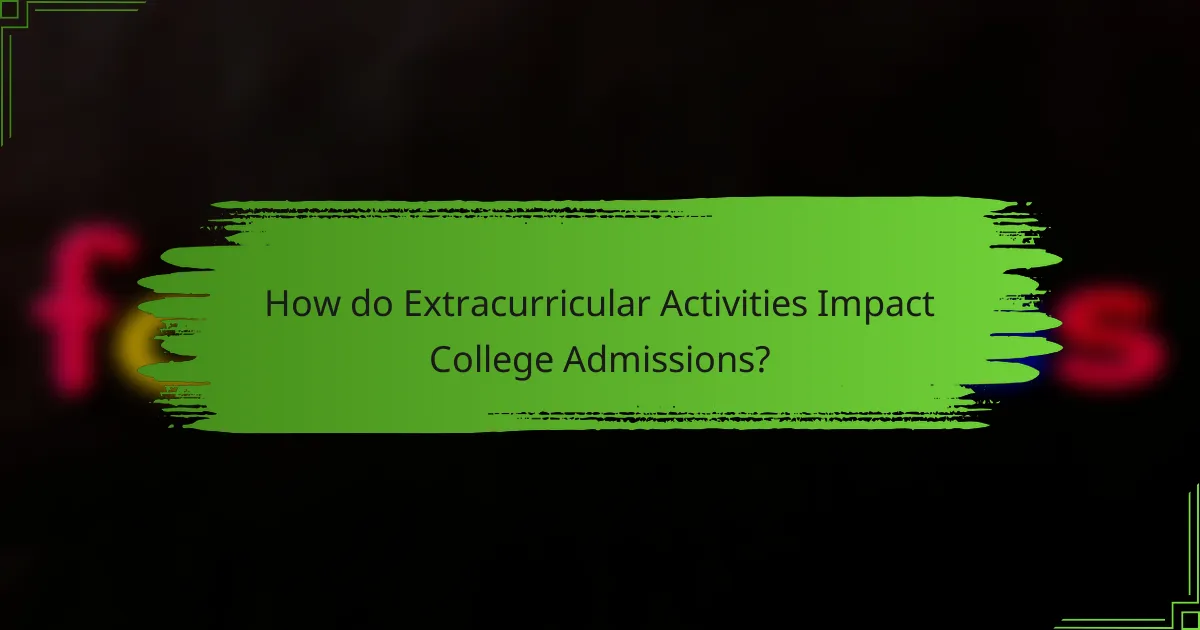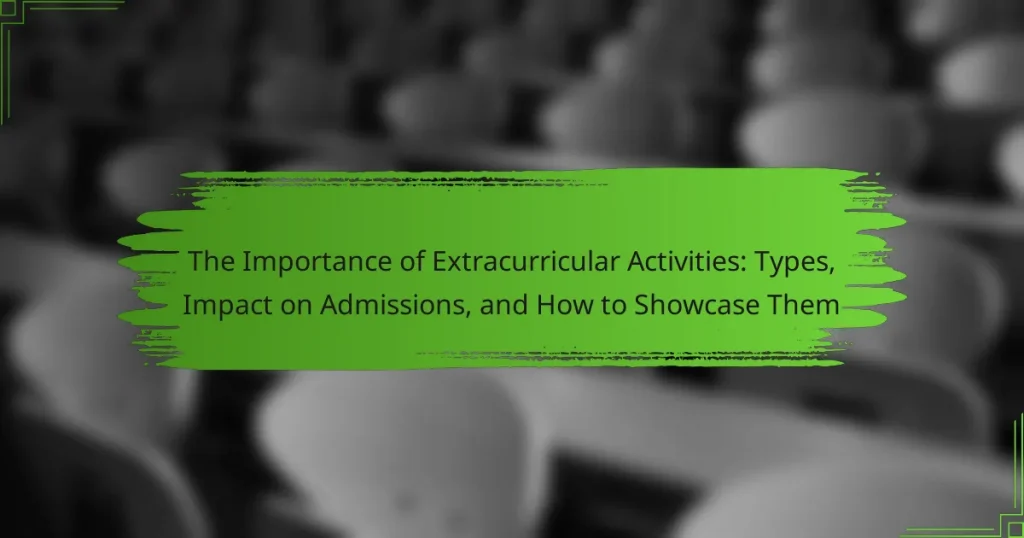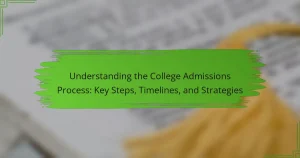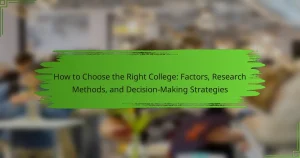
What are Extracurricular Activities?
Extracurricular activities are non-academic pursuits that students engage in outside of their regular school curriculum. These activities can include sports, clubs, music, arts, and community service. Participation in extracurricular activities fosters personal growth and skill development. Research shows that students involved in such activities often exhibit improved social skills and higher academic performance. According to the National Center for Education Statistics, approximately 80% of high school students participate in at least one extracurricular activity. This involvement can enhance college applications by demonstrating leadership and commitment.
How do Extracurricular Activities differ from Academic Activities?
Extracurricular activities differ from academic activities in their primary focus and purpose. Extracurricular activities are non-academic pursuits that occur outside of the standard curriculum. They include sports, clubs, and volunteer work. These activities promote personal development, social skills, and teamwork. Academic activities, on the other hand, are directly related to the educational curriculum. They involve subjects like math, science, and literature. Academic activities are designed to assess knowledge and skills through exams and assignments. Research shows that participation in extracurricular activities can enhance academic performance and college admissions prospects.
What are the various forms of Extracurricular Activities?
Extracurricular activities encompass a wide range of pursuits outside the standard curriculum. These include sports teams, clubs, music and arts programs, volunteer work, and student government. Sports teams offer physical engagement and teamwork skills. Clubs can range from academic-focused groups to hobby-based interests. Music and arts programs foster creativity and self-expression. Volunteer work promotes community involvement and social responsibility. Student government provides leadership experience and civic engagement. Each form contributes to personal development and enhances college applications.
Why are Extracurricular Activities important for personal development?
Extracurricular activities are important for personal development because they enhance skills, foster social connections, and build self-confidence. Participation in these activities allows individuals to explore interests outside of academics. This exploration can lead to improved time management and organizational skills. Engaging in teamwork helps develop collaboration and communication abilities. Moreover, extracurricular activities provide opportunities for leadership experiences. Studies show that students involved in such activities often perform better academically. According to the National Center for Education Statistics, students engaged in extracurriculars have higher GPAs and graduation rates. These activities also promote a sense of belonging and community. Overall, they contribute significantly to holistic personal growth.
What role do Extracurricular Activities play in student life?
Extracurricular activities play a crucial role in student life by enhancing personal development and social skills. They provide opportunities for students to explore interests outside the academic curriculum. Participation in these activities fosters teamwork and leadership abilities. Students engaged in extracurriculars often experience improved time management skills. Research indicates that involvement in such activities can lead to higher academic performance. According to the National Center for Education Statistics, students involved in extracurricular activities are more likely to graduate from high school. Moreover, these activities can strengthen college applications by showcasing well-rounded candidates. Overall, extracurricular activities contribute significantly to a student’s holistic development.
How do Extracurricular Activities foster social skills?
Extracurricular activities foster social skills by providing opportunities for interaction and collaboration. These activities encourage teamwork, as participants often work together towards common goals. Engaging in clubs or sports helps individuals develop communication skills through discussions and shared experiences. Additionally, they promote conflict resolution skills when disagreements arise among peers. Participation in diverse groups exposes individuals to various perspectives, enhancing empathy and understanding. Research indicates that students involved in extracurricular activities report higher levels of social competence. A study by the National Center for Education Statistics found that students engaged in these activities tend to have better relationships with peers and adults.
In what ways do Extracurricular Activities enhance academic performance?
Extracurricular activities enhance academic performance by improving time management skills. Students involved in these activities learn to balance their academic and personal commitments. This balance often leads to better organizational skills, which can translate to improved study habits. Additionally, participation in such activities fosters social skills and teamwork, which can enhance communication abilities in academic settings.
Research shows that students engaged in extracurriculars tend to have higher GPAs. A study by the National Center for Education Statistics found that students involved in extracurricular activities are more likely to perform well academically. Furthermore, these activities can boost motivation and engagement in schoolwork. By participating in clubs or sports, students often develop a sense of belonging, which can increase their commitment to their studies.

What Types of Extracurricular Activities Exist?
Extracurricular activities can be categorized into several types. These include sports, arts, academic clubs, community service, and student government. Sports activities involve participation in physical competitions, such as soccer or basketball. Arts activities encompass music, theater, and visual arts. Academic clubs focus on subjects like debate, science, or math. Community service activities involve volunteering for local organizations or causes. Student government allows students to engage in leadership and governance within their school. Each type of activity provides unique benefits and opportunities for personal growth and skill development.
How can students categorize their Extracurricular Activities?
Students can categorize their extracurricular activities into several distinct groups. Common categories include academic, athletic, artistic, community service, and leadership roles. Academic activities may involve clubs like debate, science fairs, or student government. Athletic activities encompass sports teams, individual sports, and fitness clubs. Artistic activities include music, theater, and visual arts. Community service activities involve volunteering and social initiatives. Leadership roles can be found in student organizations and clubs. This categorization helps students present a well-rounded profile to colleges and employers.
What are the most common types of Extracurricular Activities?
The most common types of extracurricular activities include sports, clubs, arts, and community service. Sports activities often involve team or individual competitions. Popular sports include soccer, basketball, and swimming. Clubs can range from academic organizations to hobby groups. Examples are debate club, science club, and chess club. Arts activities encompass music, theater, and visual arts. Students may participate in band, drama, or painting classes. Community service activities involve volunteering and helping others. Examples include food drives, tutoring, and environmental clean-ups. These activities enhance skills, build friendships, and improve college applications.
How do specialized clubs and organizations fit into Extracurricular Activities?
Specialized clubs and organizations are integral components of extracurricular activities. They provide students with opportunities to explore specific interests beyond the academic curriculum. These clubs often focus on particular subjects, hobbies, or causes, such as science, art, or community service. Participation in these organizations fosters skills like teamwork, leadership, and time management. Research shows that students involved in specialized clubs are more likely to develop a strong sense of belonging and community. Additionally, admissions committees often view involvement in such activities favorably, as they indicate a student’s commitment and passion. Specialized clubs enhance the overall educational experience by promoting personal growth and social interaction.
What unique benefits do different types of Extracurricular Activities offer?
Different types of extracurricular activities offer unique benefits that enhance personal development and skills. Sports activities promote teamwork and physical fitness. Academic clubs foster critical thinking and subject mastery. Arts programs encourage creativity and self-expression. Volunteer work builds empathy and community awareness. Leadership roles develop organizational and communication skills. Each type contributes distinctively to a well-rounded education. For instance, participation in sports can improve physical health by reducing obesity risks, while involvement in volunteer work can increase social responsibility. These activities collectively prepare students for future challenges and opportunities.
How do sports contribute to teamwork and leadership skills?
Sports foster teamwork and leadership skills through collaborative experiences. When participating in sports, individuals must work together to achieve common goals. This requires communication, trust, and mutual support among team members. According to a study by the National Federation of State High School Associations, 93% of coaches believe that sports teach valuable life skills, including teamwork. Additionally, sports often place individuals in leadership roles, such as team captain, which enhances their ability to guide and motivate others. Research from the American Psychological Association indicates that team sports improve social skills and emotional intelligence, both critical for effective leadership. Overall, sports provide a practical environment for developing essential teamwork and leadership abilities.
What advantages do arts and cultural activities provide for creativity?
Arts and cultural activities enhance creativity by fostering innovative thinking and self-expression. They provide opportunities for individuals to explore diverse perspectives. Engaging in these activities stimulates the brain’s creative processes. Research shows that participation in arts improves problem-solving skills. A study by the National Endowment for the Arts found that arts involvement increases cognitive abilities. Furthermore, these activities encourage collaboration and teamwork, essential for creative endeavors. They also promote emotional intelligence, which is linked to creative expression. Overall, arts and cultural activities are vital for nurturing creativity.

How do Extracurricular Activities Impact College Admissions?
Extracurricular activities significantly influence college admissions decisions. Colleges seek well-rounded candidates who demonstrate skills beyond academics. Participation in clubs, sports, or community service showcases leadership, teamwork, and commitment. According to the National Association for College Admission Counseling, 70% of colleges consider extracurricular involvement as a key factor. Engaging in meaningful activities can also enhance personal statements and interviews. These experiences provide context to academic achievements. They help admissions officers gauge a student’s potential contributions to campus culture. Overall, active involvement in extracurriculars can enhance a candidate’s appeal in a competitive admissions landscape.
Why are Extracurricular Activities considered in the admissions process?
Extracurricular activities are considered in the admissions process because they demonstrate a student’s interests and skills beyond academics. Admissions committees seek well-rounded candidates who show leadership, teamwork, and commitment. Participation in clubs, sports, or community service highlights a student’s ability to manage time effectively. Research shows that students involved in extracurriculars often perform better academically. According to a study by the National Center for Education Statistics, students engaged in extracurricular activities have higher GPAs. These activities also provide insight into a student’s character and potential contributions to campus life. Thus, they play a significant role in holistic admissions evaluations.
How do colleges evaluate Extracurricular Activities on applications?
Colleges evaluate extracurricular activities by assessing the depth and impact of a student’s involvement. They look for leadership roles, commitment over time, and the significance of the activities to the applicant’s personal development. Admissions committees seek to understand how these experiences contribute to the candidate’s character and potential contributions to the campus community. Specific metrics include the duration of participation, level of responsibility, and any recognition received. According to the National Association for College Admission Counseling, 70% of colleges consider extracurricular activities as a significant factor in admissions decisions. This highlights the importance of showcasing meaningful involvement in applications.
What specific qualities do admissions officers look for in Extracurricular Activities?
Admissions officers look for commitment, leadership, and impact in extracurricular activities. Commitment demonstrates a student’s dedication and ability to manage time effectively. Leadership showcases the capacity to inspire and guide others. Impact reflects the significance of a student’s contributions to their community or organization. These qualities indicate a well-rounded individual who can contribute positively to the campus environment. Admissions data shows that students with strong extracurricular involvement often have higher acceptance rates.
What is the relationship between Extracurricular Activities and personal statements?
Extracurricular activities significantly enhance personal statements. They provide concrete examples of skills and experiences. Admissions committees value these activities as indicators of character and commitment. Engaging in extracurriculars demonstrates leadership, teamwork, and time management. These attributes are crucial for success in academic environments. Personal statements that include extracurricular involvement often stand out. They illustrate a well-rounded applicant profile. This relationship is vital in the college admissions process.
How can students effectively highlight their Extracurricular Activities in essays?
Students can effectively highlight their extracurricular activities in essays by using specific examples and clear descriptions. They should begin by selecting activities that showcase their skills and interests. Each activity should be described with details about their role and contributions. Students should explain the impact of these activities on their personal growth. Quantifying achievements, such as awards or leadership positions, adds credibility. Connecting activities to future goals demonstrates relevance. Using a narrative style can engage readers and provide context. Lastly, ensuring that the writing is concise and focused maintains clarity.
What common mistakes should students avoid when discussing Extracurricular Activities?
Students should avoid being vague when discussing extracurricular activities. Specificity enhances clarity and impact. They often fail to articulate their roles and contributions. This omission can lead to misunderstandings about their involvement. Additionally, students may exaggerate their achievements. Overstating accomplishments can damage credibility. They sometimes neglect to connect activities to personal growth or skills gained. This connection is crucial for demonstrating value. Lastly, students might overlook the importance of reflection on their experiences. Reflective insights provide depth and meaning to their discussions.

How to Showcase Extracurricular Activities Effectively?
To showcase extracurricular activities effectively, highlight leadership roles and achievements. Clearly outline your responsibilities in each activity. Use quantifiable results to demonstrate impact, such as event attendance or fundraising totals. Include relevant skills gained, like teamwork or time management. Tailor descriptions to align with the audience’s interests or values. Use a clean and organized format for presentation. Visuals or portfolios can enhance engagement. Research shows that admissions committees value clear and concise representations of involvement.
What strategies can students use to present their Extracurricular Activities?
Students can use several strategies to effectively present their extracurricular activities. First, they should create a structured resume that highlights relevant experiences. This resume should include the name of the activity, duration, and specific roles. Next, students can use storytelling techniques to describe their involvement. They should focus on challenges faced and skills gained. Additionally, students can prepare a digital portfolio showcasing photos, videos, and achievements. This can enhance their presentation and provide visual proof of their contributions. Networking with mentors can also help students refine their presentation skills. Lastly, practicing public speaking can increase confidence during interviews or presentations. These strategies ensure that students effectively communicate their extracurricular involvement.
How can students create a compelling resume of Extracurricular Activities?
Students can create a compelling resume of extracurricular activities by clearly listing their involvement and achievements. Begin by organizing activities chronologically or by category. Include the name of the organization, position held, and dates of participation. Describe specific responsibilities and accomplishments in concise bullet points. Use action verbs to highlight contributions and skills gained. Quantify achievements when possible, such as membership numbers or events organized. Tailor the resume to the target audience, emphasizing relevant experiences. Ensure the format is clean and professional for easy readability. This structured approach effectively showcases the student’s commitment and skills to admissions committees.
What role do recommendation letters play in showcasing Extracurricular Activities?
Recommendation letters play a crucial role in showcasing extracurricular activities. They provide an external validation of a student’s involvement and achievements. These letters highlight specific contributions and skills demonstrated in activities. They can reflect leadership, teamwork, and commitment. Additionally, recommendation letters can offer personal anecdotes that illustrate a student’s character. This context helps admissions committees understand the impact of the student’s extracurricular engagement. Ultimately, strong recommendation letters enhance the overall application by adding depth to the student’s profile.
What are the best practices for discussing Extracurricular Activities in interviews?
Highlight relevant extracurricular activities that showcase skills and interests. Be specific about your roles and achievements in these activities. Use the STAR method to structure your responses, focusing on Situation, Task, Action, and Result. Discuss how these activities contributed to your personal growth and teamwork abilities. Relate your experiences to the job requirements and company culture. Practice articulating your experiences clearly and confidently. Prepare to answer follow-up questions about your involvement and learning outcomes. Tailor your discussion to align with the values of the organization you are interviewing with.
How can students prepare to talk about their Extracurricular Activities confidently?
Students can prepare to talk about their extracurricular activities confidently by practicing their presentation skills. They should start by listing their activities and identifying key achievements in each. This helps in organizing thoughts and highlights important points. Students can rehearse their descriptions aloud. This builds familiarity and reduces anxiety. Seeking feedback from peers or mentors can provide valuable insights. They should also prepare for common questions about their involvement and impact. Finally, using positive body language during discussions can enhance their confidence.
What tips can help students connect their Extracurricular Activities to their future goals?
Students can connect their extracurricular activities to future goals by identifying relevant skills gained. They should reflect on how these skills apply to their desired career paths. For example, leadership roles in clubs enhance management abilities. Volunteering demonstrates commitment to community service, which is valued in many professions. Networking with peers and mentors in these activities can provide insights into career opportunities. Additionally, students should document accomplishments in a portfolio. This can showcase their growth and experiences to potential employers. Tailoring resumes to highlight these connections can make applications more compelling. Engaging in discussions about experiences can also clarify how they align with future aspirations.
Extracurricular activities are non-academic pursuits that play a vital role in student development and college admissions. This article explores the various types of extracurricular activities, their impact on personal growth, social skills, and academic performance. It also highlights how these activities enhance college applications by showcasing leadership and commitment, detailing strategies for effectively presenting them in applications and interviews. Key insights include the importance of categorizing activities, the unique benefits of different types, and best practices for discussing experiences confidently.




